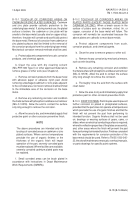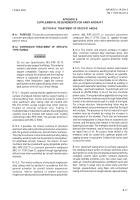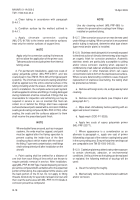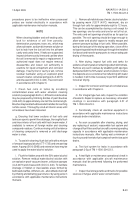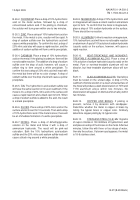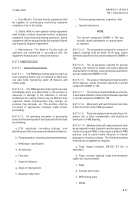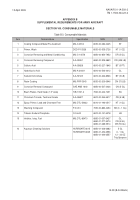TM-1-1500-344-23-2 - Page 227 of 240
B-25
NAVAIR 01-1A-509-2
TM 1-1500-344-23-2
15 April 2009
B-22. GENERAL.
The metal identification kit (FSN
6630-831-5932) shall be used to determine the types of
metal(s) used in the construction of aircraft. The use of
this kit employs two methods of identification: (a) primary
classification of metals; and (b) chemical spot analysis.
See
Table
B-2.
NOTE
Before proceeding with test, remove paint (if
present) from a one inch square area with cloth
soaked in an approved compliant solvent
cleaner.
B-23. PRIMARY CLASSIFICATION
.
a. For a preliminary identification, compare metal
strips in the kit with unknown metal on aircraft.
b. Place a magnet on the metal surface. Magnetic
attraction classifies the base metal as a ferrous magnetic
material (i.e., iron or steel).
B-24. CHEMICAL SPOT ANALYSIS
. Chemical tests
are used to identify a base metal and/or plating. If the
base metal is plated and its identification is desired, the
plating must be mechanically removed by abrasion
before tests are made. Surrounding surface treatments
of the metal will not interfere with these tests.
B-25. TESTING PROCEDURES FOR TYPES OF
SURFACE TREATMENT.
B-25.1. PHOSPHATE TREATMENT. To confirm the
presence of a phosphate treatment on steel, zinc,
cadmium, or aluminum, place a drop of 20% nitric acid
solution on the surface and follow this with two drops of
ammonium molybdate solution. If the metal surface has
had a phosphate treatment, a yellow precipitate will
form.
B-25.2. CHROMATE TREATMENT. Surface chromate
treatments on zinc, cadmium, aluminum, or magnesium
are highly colored and are indicative of the application
of these treatments. A bleached chromate treatment
may have been applied, however, and then coated with
lacquer to mask any residual iridescence for the sake of
appearance. If so, visual detection of the chromate is
impossible. To test for this lacquer, proceed as directed
in the following paragraph.
B-25.2.1.
Test for Lacquer. Place a drop of
concentrated sulfuric acid on the surface. If lacquer is
present, the spot will rapidly turn brown with no
effervescence. If lacquer is not present, the spot will not
turn brown. If the metal is zinc, there will be a rapid
effervescence; if cadmium, there will be no reaction.
B-25.2.2.
Test for Chromate Film on Zinc Chromium.
Place a drop of 5% aqueous solution of lead acetate on
the surface. If the metal has been treated, the surface
will show no discoloration for 10 seconds. If there is no
surface treatment, an immediate dark spot will appear.
NOTE
A bleached chromate treatment is not approved
because the bleaching process lowers corrosion
resistance of metal.
B-26. CONTENTS OF METAL IDENTIFICATION KIT.
This kit consists of metal strips (1.0 x 6.0 x 0.063 cubic
inches) to be used for visual comparison and practice,
and reagents to be used for performing a chemical spot
analysis. Conduct the following test procedures:
NOTE
Where tests have been conducted, it will be
necessary to remove the test chemical,
neutralize the surface, and apply the original
paint coating. Where plating has been removed,
recoat with two coats of epoxy primer
(MIL-PRF-23377).
B-26.1. IRON AND STEEL. Place a drop of 10%
hydrochloric acid on the metal surface. The acid will not
noticeably react on iron or steel. Place a drop of sodium
sulfide over the drop of hydrochloric acid. This will
cause a black ring to form around a white precipitate. To
confirm this test, a drop of 20% nitric acid on iron or steel
will cause a black spot, and a drop of sodium sulfide
over the nitric acid will cause a black precipitate. If the
steel or iron has been bonderized, the spot will appear
as a black ring around a white spot in both tests. This is
not a test for bonderizing process.
APPENDIX B
SUPPLEMENTAL REQUIREMENTS FOR ARMY AIRCRAFT
SECTION VI. IDENTIFICATION OF METALS
Back to Top

